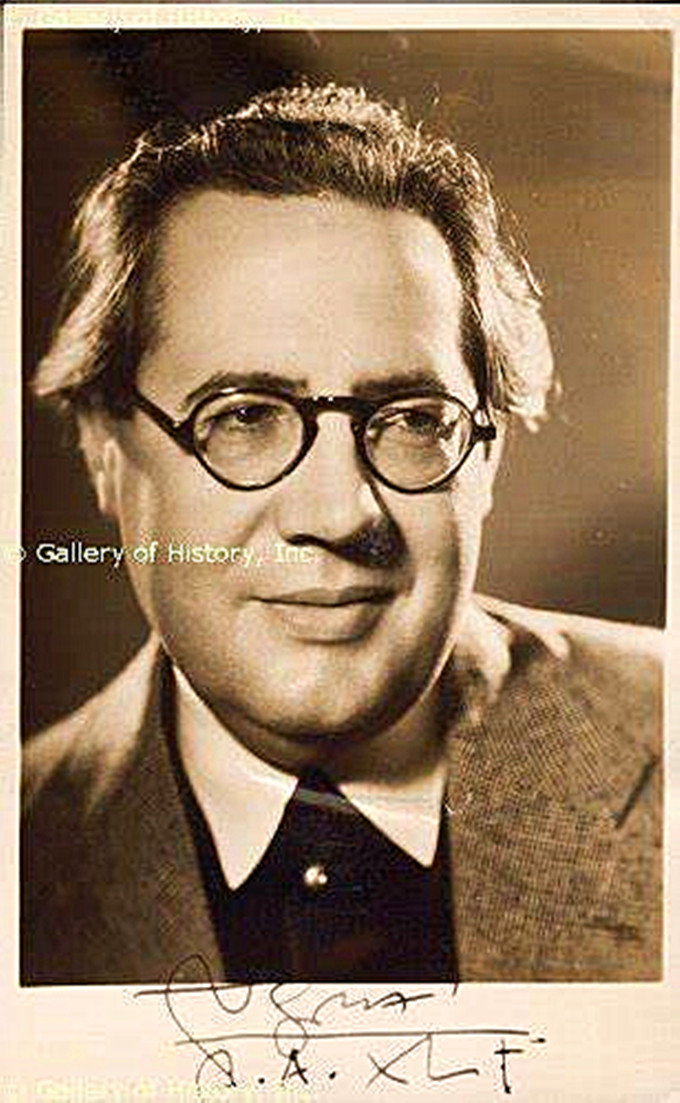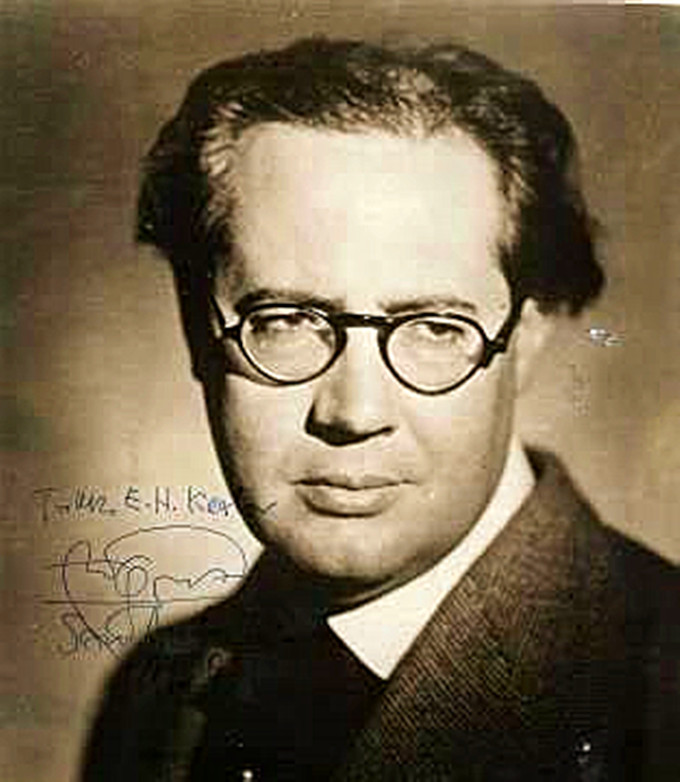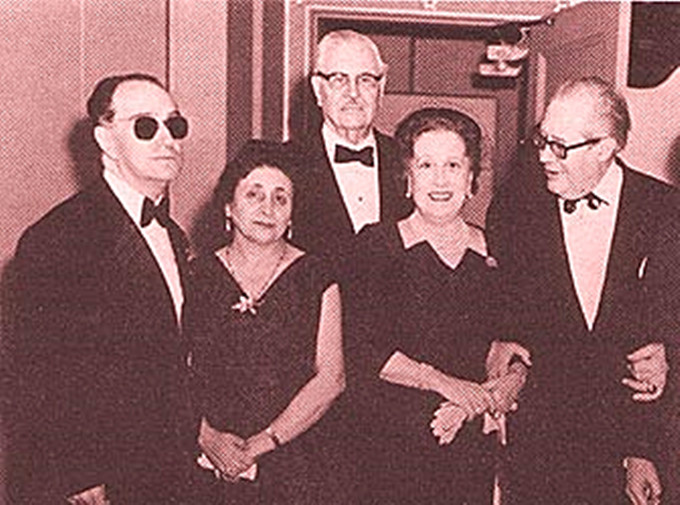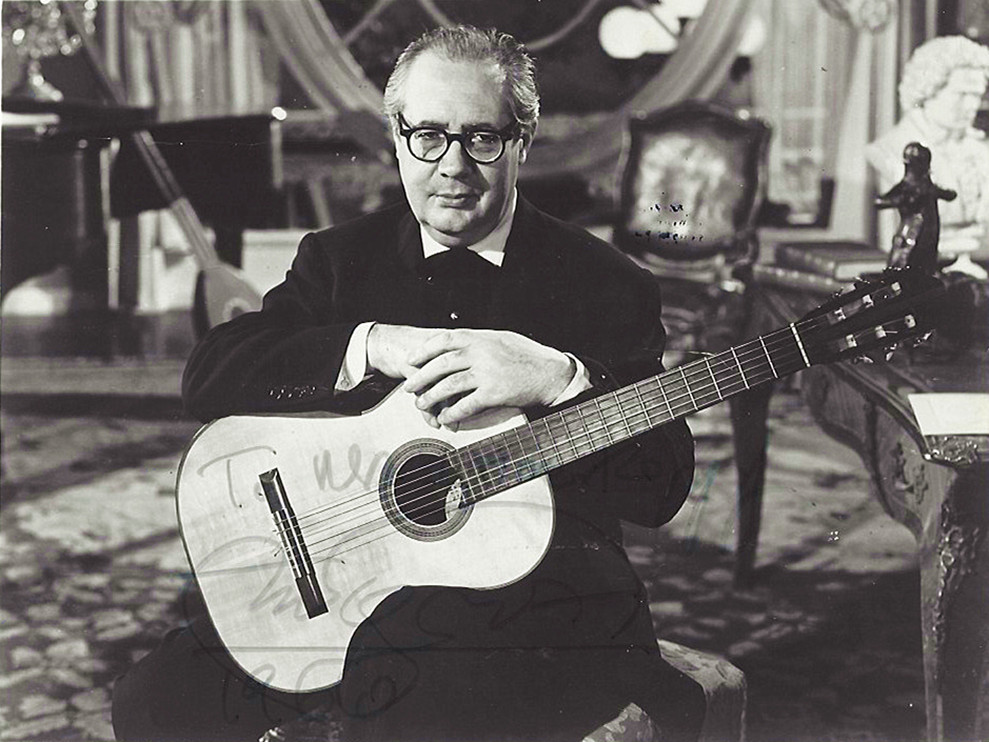| |
|
|
|
|
|
|
|
|
|
|
| |
| |
 |
|
| |
田润德
编译
文/图 2020-02-21 16:36 |
|
| |
|
|
|
|
| |
 |
|
|
|
| |
安德烈斯·塞戈维亚(Andres Segovia
1893-1987) |
|
|
|
| |
|
|
|
|
| |
神级演奏!塞戈维亚演奏古典吉他 bwv999 魔笛 鸣奏曲 Andres Segovia
|
|
|
|
| |
solo instrumental
Andrfes
Segovia, guitar(1893-1987)
‘Prelude
for Lute (J.S.Bach)
Variations
on a Theme of mozart (F.Sor)
'Sonatina'
(F.M.Torroba)
(courtesy
of Christopher Parkening)
"Christopher
Parkening-Virtuoso Performances"
Hal-Leonard
Corporation |
|
独奏乐器
安德烈斯·塞戈维亚,吉他(1893-1987)
“前奏曲-琉特琴”(约·塞·巴赫)
《莫扎特主题曲变奏曲(F.Sor)
《索纳蒂纳》(F.M.Torroba)
(由克里斯托弗·帕克宁提供)
《克里斯托弗·帕克宁-维尔图索表演》 |
|
| |
|
|
|
|
| |
音乐历史上的今天
1893年2月21日,重振吉他作为古典乐器声威的安德烈斯·塞戈维亚( Andres
Segovia)在格拉纳达出生。他在90岁高龄之际回忆道:“我有过三任妻子,三把吉他,尽管如此,我还是会同其他女人和其他吉他眉来眼去。”
安德烈斯·塞戈维亚(Andres
Segovia,1893年2月21日-1987年6月2日),当代最杰出的西班牙吉他演奏家,具有“古典吉他之父”之美誉。
他一生的活动,使吉他这种乐器的地位得到提高,使吉他音乐在二十世纪获得了强盛的生命力。
他曾说:“我爱秩序,清澄与均衡。”他的演奏音色美妙,技巧高超,音乐充满人情味,格调高雅优美而具有深度。克莱斯勒曾说:“世界上真正伟大的弦乐器演奏家只有两位--卡萨尔斯与塞戈维亚。”
许多优秀的演奏家的个性及气质与他所擅长的乐器似乎有一种神秘的关系,塞戈维亚就是一例。他自幼对小提琴、大提琴、钢琴毫无兴趣,却对“不登大雅之堂”的民间乐器吉他的诗意的、美的音响有着特殊的感受力。有一天,塞戈维亚在著名的吉他制造家拉米烈斯的工场里看到一把优质吉他,便忘情地弹奏起来。恰被在场的皇家音乐学院小提琴教授听到,就对他说:“你出众的音乐才能浪费在吉他上太可惜了,如果跟我学小提琴一定会一举成名的。”塞戈维亚回答:“谢谢你,大师。我愿意具有历史上许多小提琴家的永生不渝的奋斗精神,但我更愿意为未来的吉他世界铺路,这将是我最大的幸福。”
塞戈维亚完全是自学成才的,他痛恨他的第一位音乐老师,因为他脾气暴躁,而且在安德烈斯犯错时掐他的胳膊。他说,“自从那以后,我自己是我的老师,也是学生,所以在我一生中,至今从没有发生过先生跟学生顶撞的事。”
塞戈维亚体态丰满,他的手型巨大。最初,吉他不是用指甲弹奏就是用指尖弹奏。塞戈维亚使用了这两种方法,这给了他一个非凡的调色板可供选择。塞戈维亚凭借他的天赋和毅力,打开一道道艺术之门,带着心爱的吉他走处西班牙,他的音乐和名声也响彻世界各地。
今日视频:1、塞戈维亚演奏巴赫《琉特琴前奏曲》和根据莫扎特音乐写成的《魔笛变奏曲》。2、罗德里戈(Joaquín
Rodrigo Vidre)题献给塞戈维亚的《绅士幻想曲》。 |
|
|
|
| |
 |
|
|
|
| |
安德烈斯·塞戈维亚(Andres Segovia) |
|
|
|
| |
|
|
|
|
| |
Today in music
history
Andres Segovia, who revived the guitar as a classical instrument, was
born in granada on February 21, 1893."I had three wives and three
guitars," he recalls at the age of 90. "I was still flirting with other
women and other guitars."
Andres Segovia (February 21, 1893 -- June 2, 1987) was one of the
greatest Spanish guitarists of his generation.His life's activities, the
guitar as an instrument to enhance the status of the 20th century guitar
music has gained strong vitality."I love order, clarity and balance," he
once said.His playing is beautiful in tone and skill. His music is full
of human touch. His style is elegant, graceful and deep.Chrysler once
said, "there are only two truly great stringers in the world -- casals
and segovia."
Segovia is an example of an excellent performer whose personality and
temperament seem to have a mysterious relationship with the instrument
at which he excels.He had no interest in violin, cello and piano since
he was young, but he had a special sensibility for the poetic and
beautiful acoustics of the guitar, a folk instrument.One day segovia saw
a good guitar in the workshop of the famous guitar-maker ramirez and
began to play it.When the professor of violin at the royal college of
music heard him, he said, "it's a pity that your outstanding musical
ability is wasted on the guitar.Segovia replied, "thank you, master.I
would like to have the eternal fighting spirit of many violinists
throughout history, but I would like to pave the way for the future
guitar world, which will be my greatest happiness."
Segovia was completely self-taught, and he hated his first music teacher
for his short temper and for pinching andres on the arm when he made a
mistake."Since then, I have been both a teacher and a student myself, so
I have never had a confrontation with a student in my life," he said.
Segovia was plump and his hands enormous.Originally, guitars were played
with either fingernails or fingertips.Segovia used both methods, which
gave him a remarkable palette to choose from.With his talent and
perseverance, segovia opened the doors of art, took his beloved guitar
to Spain, and made his music and fame heard all over the world.
Today's video: 1. Segovia plays Bach's "lute prelude" and "magic flute
variations" based on Mozart's music.2. "gentlemen's fantasia" by Joaquin
Rodrigo Vidre, dedicated to segovia. |
|
|
|
| |
 |
|
|
|
| |
两个古典吉他大师塞戈维亚(Andres
Segovia)和罗德里戈(Joaquín
Rodrigo Vidre)在西班牙相遇。 |
|
|
|
| |
 |
|
| |
塞戈维亚(Andres Segovia) |
|
|
|
| |
塞戈维亚于1908年在格拉纳达的艺术中心第一次举行独奏音乐会。后到西班牙的科尔多瓦和塞维利亚.1912年来到西班牙首都马德里,接受名匠努埃尔.拉米列斯赠送的吉他名器.翌年二十岁,在马德里艺术院沙龙举行独奏会。1915年在帕伦西亚与塔雷加的高足、当时首屈一指的吉他演奏家廖贝特相识并深受影响。后来他们一起到巴塞罗那,1916年在该市举办的演奏会多达十五次。次年在马德里举行多次音乐会,同时也到法国南部演出。1919年第一次赴南美洲旅行演出。1922年在格拉纳达参加由西班牙作曲家法雅主办的艺术节的演出。
1924年4月7日塞戈维亚在巴黎音乐学院的音乐厅举行了在巴黎第一次的独奏音乐会。当时,法国作曲家杜卡和西班牙作曲家法雅以及德彪西夫人等都到场欣赏。这次音乐会使塞戈维亚在国际乐坛上一举成名。当时的评论写道:“塞戈维亚为音乐公众发现了吉他!”法国著名作曲家鲁塞尔(Albert
Roussel,1869-1937)深受感动,于是翌年创作吉他独奏曲《塞戈维亚》(作品29),并将该乐曲题献给塞戈维亚。到巴黎之后,塞戈维亚与巴西作曲家维拉-罗勃斯结成知交。同时也跟墨西哥作曲家曼努埃尔.庞塞、西班牙作曲家托罗巴等作曲家相识。为了丰富吉他音乐的曲目,从这个时期起,塞戈维亚经常约请作曲家创作吉他乐曲。其中包括庞塞的《古典奏鸣曲》、《浪漫风格奏鸣曲》,泰代斯科的《卡伐帝那组曲》
、罗德里戈的《阿兰胡埃斯吉他协奏曲》等。与这同时,他自己也亲自动手创作
《练习曲集(每日的功课)》等几首吉他曲,并且发掘巴赫的鲁特琴乐曲,把古今的乐曲改编成为吉他曲向听众推广。由他改编的吉他曲,有一百五十首以上。 |
|
|
|
| |
Segovia gave his
first recital at the center for the arts in granada in 1908.In 1912, he
came to Madrid, the capital of Spain, and received a guitar instrument
from the famous artist Noel ramirez.In 1915, in palencia, he met and was
deeply influenced by Leo bette, the high and leading guitarist of
tarrega.Together they went to Barcelona, where they performed as many as
fifteen times in 1916.The following year, he performed several concerts
in Madrid and also in the south of France.First tour to South America in
1919.In 1922 he performed at an art festival in granada organized by the
Spanish composer faya.
On April 7, 1924, segovia gave his first recital in Paris at the concert
hall of the Paris conservatory.At that time, the French composer duca
and Spanish composer faye and madame Debussy were present to
appreciate.The concert made segovia famous on the international music
scene."Segovia discovered the guitar for the music public!" the review
read at the time.The famous French composer Albert Roussel (1869-1937)
was so moved that he dedicated his guitar solo segovia (op.29) to
segovia the following year.After arriving in Paris, segovia befriended
the Brazilian composer vera robbs.He was also acquainted with Mexican
composer Manuel Ponce and Spanish composer toroba.In order to enrich the
repertoire of guitar music, segovia often invited composers to compose
guitar music from this period.Among them are Ponce's classical sonata,
romantic style sonata, tedesco's cavatina suite, rodrigo's alain huis
guitar concerto and so on.At the same time, he also created several
guitar songs by himself, such as "practice collection (daily lessons)",
and explored Bach's lute music, and adapted ancient and modern music
into guitar songs for the audience.He has composed more than 150 guitar
songs. |
|
|
|
| |
|
|
|
|
| |
|
|
|
|
| |
罗德里戈《绅士幻想曲》| Sanel Redzic
|
|
|
|
| |
《绅士幻想曲》——华金·罗德里戈
《我的村庄和我的车》
04:25第二部《西班牙》和《那不勒斯的卡巴列里亚》
13:50第三部《我的村庄和我的车》
16:15第四部《卡纳里奥》
|
|
|
|
| |
罗德里戈题献给塞戈维亚的《《绅士幻想曲》》 |
|
|
|
| |
《绅士幻想曲》(西班牙语:Fantasía para un
gentilhombre)是西班牙作曲家华金·罗德里戈(Joaquín
Rodrigo)为古典吉他与管弦乐团所作的吉他名曲。此曲是罗德里戈继《阿兰惠斯协奏曲》之后第二受欢迎的作品。
此曲是罗德里戈应吉他大师安德烈斯·塞戈维亚(Andrés
Segovia)的请求,写作于1954年,并题献给塞戈维亚。首演于1958年3月旧金山歌剧院,塞戈维亚亲自担任吉他独奏部分。
罗德里戈创作此曲的灵感,来自于他有一次听到妻子以钢琴演奏加斯帕·桑斯(Gaspar
Sanz)的作品。桑斯是17世纪的巴洛克时期作曲家,罗德里戈依据1674年出版的一本桑斯的曲集中为吉他独奏所写的六首短的舞曲,加以改编及扩充成四个乐章的《绅士幻想曲》。至于曲名中的“绅士”所指为何,罗德里戈说:“你把他想像成桑斯或是塞戈维亚都可以。”
1954年秋,罗德里戈完成了这部作品,并题献给了塞戈维亚。1958年3月3日,《绅士幻想曲》在美国旧金山的旧金山歌剧院首演。塞戈维亚担任吉他独奏,恩里克·约尔达(Enrique
Jorda)指挥旧金山交响乐团协奏。
罗德里戈采用了更加自由的四乐章的形式。虽然作曲家把这部作品称作“幻想曲”,但从它的方方面面来看,它与传统的协奏曲也只有上述这一点点区别。罗德里戈在这四个乐章的所有主要的主题均引用了桑斯了作品,力求通过这部作品把17世纪的吉他演奏家、绅士——卡斯帕尔·桑斯和20世纪的吉他代言人——安德烈斯·塞戈维亚之间建立某种联系。当有人问到罗德里戈曲名中的“绅士”是指谁时,他回答说:“你把他想像成桑斯或是塞戈维亚都可以。”
第一乐章:《村民舞曲与利彻卡尔》(Villano y Ricercare.
Adagietto-Andante
moderato)。前半部分舒缓从容的村民舞曲为全曲定下了纯朴明朗优美的基调,2/2拍,A大调。利彻卡尔是16世纪至18世纪的器乐体裁名称,作为本乐章主题的桑斯原作为《西班牙民歌主题的赋格》,用模仿对位构成。罗德里戈的利彻卡尔用中庸的行板,从a小调转到D大调,4/4拍。
第二乐章:《西班牙风格宫廷舞曲与拿波里骑兵队的号声》(Espanoleta y Fanfare de
la Caballeria de Napoles. Adagio-Allegretto molto
ritmico)。前半部分的西班牙宫廷舞曲慢板速度,6/8拍,a小调,旋律舒缓优雅。随即出现的“拿波里骑兵队的号声”采用小快板,6/8拍,D大调,在这部分既能听到骑兵的马蹄声,又可以感受到骑兵的吹奏的军号声。随后再现西班牙宫廷舞曲。
第三乐章:《松明舞》(Danza de las hachas. Allegro con
brio)。雄壮的快板速度,2/2拍,情绪活泼幽默,虽简短,却带有浓郁的民间舞曲色彩。
第四乐章:《卡纳利欧》(Canario. Allegro ma non
troppo)。适度的快板,6/8拍,D大调。传说卡纳利欧舞曲起源于西非海岸卡纳利群岛,是一种开朗活泼的西班牙舞曲。载歌载舞的乐声先由吉他奏出,再由管弦乐队变化重复,最后的结束敏捷而干脆。 |
|
|
|
| |
|
|
|
|
| |
未得原作者编者授权严禁转载www.mt77.com任何内容 |
|
|
|
|
|
|
|
|
|
|
|
|
|
|


